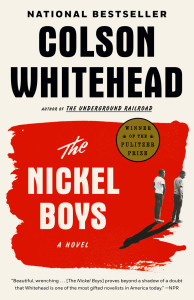As a high school student in Tallahassee, Florida in the 1960s, Ellwood Curtis studies hard and is chosen to attend classes at the university. When he isn’t studying, he listens to a record of Martin Luther King, Jr.’s speeches which fires his idealistic determination to stand up to injustice.
However, it only takes one innocent misstep to suck him into the criminal justice system. As one member of my book club who is a lawyer remarked, we don’t see the trial. Another pointed out that for a black teenager it was a foregone conclusion that he would be incarcerated.
Ellwood is sent to the Nickel Academy, a reform school for boys that Whitehead based on Florida’s actual Dozier School, which was not closed until 2011 amid longstanding accusations of beatings, sexual abuse, and even murder. For Ellwood, a young man from a protected environment, cared for and encouraged by his grandmother, the gritty truth of Nickel is a shock.
A member of my book club noted how quickly things can go wrong—something I well recall from my time on welfare—saying, “One thing unravels, and if you don’t have anyone to help it’s like a pebble rolling down a hill creating an avalanche.” Ellwood’s grandmother tries to help, hiring a lawyer, but he takes the money and disappears.
Luckily, Ellwood is befriended by Turner, another inmate who understands the system at Nickel and how to work it. A member of my book club pointed out that Turner is a fascinating character because he is so adaptable, finding ways not just to survive but to thrive even in this horrific environment. The two boys—so different—admire and support each other. Turner’s cynical realism makes him try to persuade Ellwood to keep quiet rather than speak truth to power. Yet Ellwood clings to his earlier role model: Dr. King.
The boys’ time at Nickel is framed by a story set in the 1960s where Ellwood is a successful business owner living in New York City. News stories of graves found at the now-closed Nickel Academy lead him to remember his time there.
Most of us in my book club had some quibbles about the ending, but all attested to the power of the writing.
As a writer, I paid particular attention to Whitehead’s treatment of the abuse. He himself has talked of how difficult it was for him to write about such subjects, saying in a USA Today interview, “I think if I was angry or sad every day I couldn’t create art. So the subject of slavery and the subject of the abuse in the reform school had to be held at a distance on a day to day basis.”
In order to start reading what was obviously going to be a serious book, many of us in my book club had to summon our resolve. We knew that we would be confronted by painful and terrible truths, yet knew too that it was important our eyes be opened and that we bear witness.
Though we thought that we would not be able to read some of the scenes, in fact the author pulled back and left the details to our imagination, giving us instead scenes of the aftermath, the wounds, the scars—physical and emotional: an effective technique. This is a good book to study to see how we as writers can handle shocking or gruesome scenes so that they don’t turn off readers while still moving them.
I found myself thinking of a recent talk by Heather Cox Richardson about the news of graves being found at indigenous schools in Canada. She reminded us that the people who originally created the schools were do-gooders who thought they were helping the children. They meant well. Today we see them as misguided, but at the time most white people believed that indigenous people were “savages” who needed to be “civilised” if they were to succeed in what had become a white man’s world.
How did things go so wrong? How did benevolent intentions become institutions even worse than Charlotte Brontë’s Lowood School? I’m afraid I’ve become as cynical as Turner. Too many people are willing to exchange whatever moral code they have for the rewards of corruption and power.
As Turner himself thinks, in response to Ellwood’s invocation of King’s nonviolence, “The law was one thing. You can march and wave signs around and change a law if you convinced enough white people . . . You can change the law, but you can’t change people and how they treat each other.”
How people treat each other. Starve them in order to steal food and medicine and sell it elsewhere. Sexual abuse. Power plays. It can be hard to believe that human beings can be so selfish, so unfeeling, so greedy, especially when it comes to children. But there it is.
Whether this cruelty is simply human nature or learned behaviour is not a question I can answer. The only way I can think of to combat it is to expose it and bear witness to the suffering of the victims.
Have you read this important and timely novel? What did you think of it?
